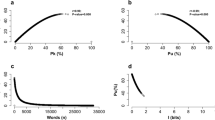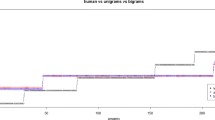Abstract
Latent semantic analysis (LSA) is a tool for extracting semantic information from texts as well as a model of language learning based on the exposure to texts. We rely on LSA to represent the student model in a tutoring system. Domain examples and student productions are represented in a high-dimensional semantic space, automatically built from a statistical analysis of the co-occurrences of their lexemes. We also designed tutoring strategies to automatically detect lexeme misunderstandings and to select among the various examples of a domain the one which is best to expose the student to. Two systems are presented: the first one successively presents texts to be read by the student, selecting the next one according to the comprehension of the prior ones by the student. The second plays a board game (kalah) with the student in such a way that the next configuration of the board is supposed to be the most appropriate with respect to the semantic structure of the domain and the previous student's moves.
Similar content being viewed by others
Explore related subjects
Discover the latest articles, news and stories from top researchers in related subjects.References
Burgess, C. and Lund, K. (1997). Modelling Parsing Constraints with High-Dimensional Context Space. Language and Cognitive Processes, 12(2/3), 177–210.
Deerwester, C., Dumais, S.T., Furnas, G.W., Landauer, T.K., and Harshmann, R. (1990). Indexing by Latent Semantic Analysis. Journal of the American Society for Information Science, 41, 391–407.
Dumais, S.T., Letsche, T.A., Littman, M.L., and Landauer, T.K. (1997). Automatic Cross-Language Retrieval Using Latent Semantic Indexing. In D. Hull and D. Oard (Eds.), 1997 AAAI Symposium on Cross–Language Text and Speech Retrieval. American Association for Artifical Intelligence.
Foltz, P.W. and Dumais, S.T. (1992). Personalized Information Delivery: An Analysis of Information Filtering Methods. Communications of the ACM, 35(12), 51–60.
Foltz, P.W. (1996). Latent Semantic Analysis for Text-Based Research. Behavior Research Methods, Instruments, &; Computers, 28(2), 197–202.
Foltz, P.W., Kintsch, W., and Landauer, T.K. (1998). The Measurement of Textual Coherence with Latent Semantic Analysis. Discourse Processes, 25, 285–307.
Kintsch, E., Steinhart, D., Stahl, G., and the LSA Research Group (2000). Developing Summarization Skills through the Use of LSA-Based Feedback. Interactive Learning Environments.
Krashen, S.D. (1988). Second Language Acquisition and Second Language Learning. Prentice-Hall International.
Landauer, T.K. and Dumais, S.T. (1997). A Solution to Plato's Problem: The Latent Semantic Analysis Theory of Acquisition, Induction and Representation of Knowledge. Psychological Review, 104(2), 211–240.
Landauer, T.K., Laham, D., Rehder, B., and Schreiner, M.E. (1997). How Well Can Passage Meaning be Derived without Using Word Order? A Comparison of Latent Semantic Analysis and Humans. In M.G. Shafto and P. Langley (Eds.), Proceedings of the 19th annual meeting of the Cognitive Science Society (pp. 412–417). Mawhwah, NJ: Erlbaum.
Lemaire, B. (1998). Models of High-Dimensional Semantic Spaces. In Proceedings of the 4th International Workshop on MultiStrategy Learning (MSL'98).
Lemaire, B. (1999). Tutoring Systems Based on Latent Semantic Analysis. In S.P. Lajoie and M. Vivet (Eds.), Artificial Intelligence in Education (Proceedings of the AIED'99 Conference) (pp. 527–534). IOS Press.
Lemaire, B. and Dessus, P. (2001). A System to Assess the Semantic Content of Student Essays. Journal of Educational Computing Research, 24(3), 303–318.
Lund K. and Burgess, C. (1996). Producing High-Dimensional Semantic Spaces from Lexical Co-Occurrence. Behavior Research Method, Instruments, &; Computers, 28(2), 203–208.
Rehder, B., Schreiner, M.E., Wolfe, M.B., Laham, D., Landauer, T.K., and W. Kintsch, W. (1998). Using Latent Semantic Analysis to Assess Knowledge: Some Technical Considerations. Discourse Processes, 25, 337–354.
Saussure, F. (1993). Saussure's Third Course of Lectures in General Linguistics. Pergamon Press.
Vygotsky, L.S. (1962). Thought and Language. Cambridge: M.I.T. Press.
Wenger, E. (1987). Artifical Intelligence and Tutoring Systems. Morgan Kaufman.
Wiemer-Hastings, P., Wiemer-Hastings, K., and Graesser, A.C. (1999). Improving an Intelligent Tutor's Comprehension of Students with Latent Semantic Analysis. In S.P. Lajoie and M. Vivet (Eds.), Artifical Intelligence in Education (Proceedings of the AIED'99 Conference) (pp. 535–542). IOS Press.
Wiemer-Hastings, P., Wiemer-Hastings, K., and Graesser, A. (1999). Approximate Natural Language Understanding for an Intelligent Tutor. In Proceedings of the 12th Florida Artificial Intelligence Research Symposium (FLAIRS'99).
Wolfe, M.B., Schreiner, M.E., Rehder, B., Laham, D., Foltz, P.W., Kintsch, W., and Landauer, T.K. (1998). Learning from Text: Matching Readers and Texts by Latent Semantic Analysis. Discourse Processes, 25(2/3), 309–336.
Author information
Authors and Affiliations
Rights and permissions
About this article
Cite this article
Zampa, V., Lemaire, B. Latent Semantic Analysis for User Modeling. Journal of Intelligent Information Systems 18, 15–30 (2002). https://doi.org/10.1023/A:1012916523718
Issue Date:
DOI: https://doi.org/10.1023/A:1012916523718




